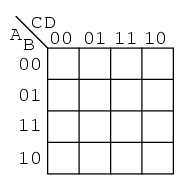Karnaugh map or K-Map provides a simple a straight-forward method of minimizing Boolean expressions. The only limitation is that will be ineffective for more than four input.
The K-Map also can also be described as a grid-like representation of truth table. The rows and columns correspond to the possible values of the function's inputs. Each cell represents the outputs the function for those possible inputs.
 |
| karnaugh map two variable |
Example :
The truth table contain two 1s. The k-map must have both of them. Locate the first 1 in the 2nd row of the truth table above.
- The truth table AB address
- Locate the cell in the K-map having the same address
- Place a 1 in that cell
Repeat the process for the 1 in the last line in the truth table.
 |
| K-map for three variable |
Example for three variable.
Mapping the four p-terms yields a group of four, which is cover by one variable C.
After the mapping six p-terms above, identify the upper group four, pick up the lower two cell of group four by sharing the two with two more from the other group. Covering these two with a group of four give a simpler result. Since there are two group, there will be two p-terms in the sum-of-product result A'+B.
 |
| K-map four variable |
Example for four variable :
The four cells above are a group of because they all have the Boolean variable B' and D' in common. In other word, B = 0 for the four cells, and D = 0 for the four cells. The other variables (A, B) are 0 in some cases, 1 in other cases with respect to the four corner cells. These variables (A, B) are not involved with this group of four. This single group comes out of the map as one product term for the simplified result : Out = B'C'
ADAM HARRIS ~.~





No comments:
Post a Comment